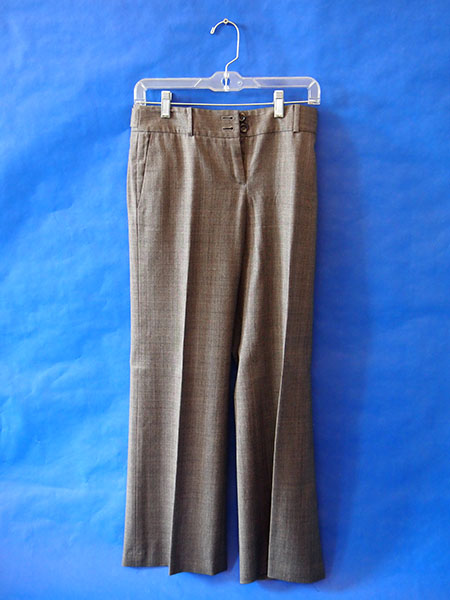![]() body | color | collections | commodity | cube | document | fabric | fetish | gender | glass | home | identity | living | machine | metal | minimal | mobility | narrative | olfactory | organic |
body | color | collections | commodity | cube | document | fabric | fetish | gender | glass | home | identity | living | machine | metal | minimal | mobility | narrative | olfactory | organic |
![]() pain | paper | plastic | plugs | power | protective | rectangular | ritual | round | sound | souvenir | spiritual | style | text-based | time | tool | touch | uniform | value | visual | warm | wood
pain | paper | plastic | plugs | power | protective | rectangular | ritual | round | sound | souvenir | spiritual | style | text-based | time | tool | touch | uniform | value | visual | warm | wood
| Clothing: Ann Taylor Gray Dress Pants | |||
Narrative: Ann Taylor Loft Gray dress pants with double buttons and zipper Made of wool from sheep, with a process that consists of: shearing; grading and sorting; grading and scouring; carding; spinning; weaving; and finishing. All of the byproducts are reused to make different grades of wool. Lanaset dyes are sold by several dye suppliers, including Paradise Fibers and PRO Chemical and Dye under their name of Sabraset. They are also sold under the brand name Telana. They are manufactured by Huntsman Textile Effects, which purchased the global Textile Effects business of Ciba Specialty Chemicals Inc. in 2006. They are acid dyes. Given to me as a gift from my father. Made of wool from sheep, with a process that consists of: shearing; grading and sorting; grading and scouring; carding; spinning; weaving; and finishing. All of the byproducts are reused to make different grades of wool. Lanaset dyes are sold by several dye suppliers, including Paradise Fibers and PRO Chemical and Dye under their name of Sabraset. They are also sold under the brand name Telana. They are manufactured by Huntsman Textile Effects, which purchased the global Textile Effects business of Ciba Specialty Chemicals Inc. in 2006. They are acid dyes. Cellulose acetate fiber is one of the earliest synthetic fibers and is based on cotton or tree pulp cellulose ("biopolymers"). These "cellulosic fibers" have been replaced in many applications by cheaper petro-based fibers (nylon and polyester) in recent decades. The Federal Trade Commission definition for acetate fiber is "A manufactured fiber in which the fiber-forming substance is cellulose acetate. Where not less than 92 percent of the hydroxyl groups are acetylated, the term triacetate may be used as a generic description of the fiber." Acetate is derived from cellulose by deconstructing wood pulp into a purified fluffy white cellulose. Spandex fibers are produced in four different ways: melt extrusion, reaction spinning, solution dry spinning, and solution wet spinning. All of these methods include the initial step of reacting monomers to produce a prepolymer. Once the prepolymer is formed, it is reacted further in various ways and drawn out to make the fibers. The solution dry spinning method is used to produce over 94.5% of the world's spandex fibers. The first step is to produce the prepolymer. This is done by mixing a macroglycol with a diisocyanate monomer. Rayon is a manufactured regenerated cellulose fiber. It is made from purified cellulose, primarily from wood pulp, which is chemically converted into a soluble compound. It is then dissolved and forced through a spinneret to produce filaments which are chemically solidified, resulting in synthetic fibers of nearly pure cellulose. Because rayon is manufactured from naturally occurring polymers, it is considered a semi-synthetic fiber. Specific types of rayon include viscose, modal and lyocell, each differs in manufacturing process and properties of the finished product. |
 |
||
![]()
